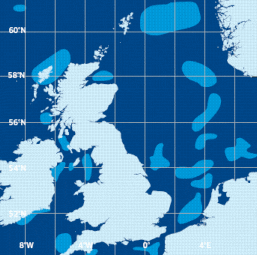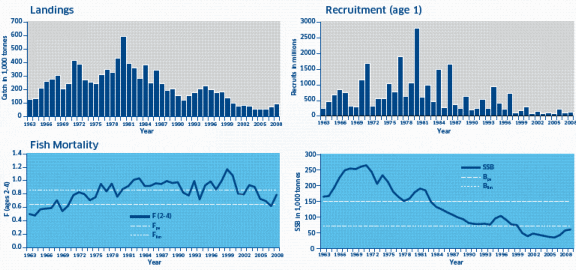Introduction

By weight, it is the third most abundant demersal species landed, with an annual value of around £13.6 million. Cod is caught by different methods both inshore and offshore. like many of the stocks in the North Sea, cod are heavily fished, with a large proportion of the stock being removed each year. The amount of cod in the sea depends very much on the numbers of young fish which survive each year to enter the adult fishery. These fish are important for maintaining the levels of the adult stock which inevitably decline through the effects of fishing. The large year to year variation in the numbers of young fish recruiting to the adult population means that controls are essential for the survival of this stock.
Biology
Cod occur mainly in the northern and central areas. New born cod are distributed over a large part of this area with high concentrations off the Jutland coast. one and two year old cod tend to overwinter in shallow coastal areas, but eventually disperse into deeper water. whilst some cod tend to reside all year around in coastal areas, the larger offshore congregations of cod tend to be migratory.

Many cod now reach maturity at two years old with 50 per cent mature by three years old. By the time they reach five years, all cod are mature. An adult female of around 80 cm can produce around four million eggs in a season. Most spawning takes place between february and March with the largest spawning areas in the northern North Sea and around dogger bank. young cod live in the upper water layers for a period before moving to the seabed in July and August. They grow quickly and can reach 20cm after one year, 50cm after two years and 80cm by the time they are four years old. By the time they reach two years old, young cod are fully exploited by the commercial fishery as the minimum landing size for cod is 35cm. Many fish are caught long before they have the chance to spawn and less than one twentieth of one year olds will survive to the age of four.

Cod do not usually browse for food on the bottom but are active feeders. By weight, around three quarters of the food of all sizes of cod consists of fish and crustaceans. The rest is made up of small quantities of molluscs and worms. As they grow, cod eat an increasing amount of fish. Sandeel, Norway pout, whiting, herring, dab and cod themselves are the main fish species eaten.
ICES ADVICE ON MANAGEMENT

Summary
- There was an increase in F due to increased discarding in 2008
- The 2008 year class is one of the lowest in time series
- Updated management plan in accordance with ICES precautionary approach
Precautionary approach reference points
For cod in the North Sea, ICES has proposed that the precautionary level for spawning stock biomass (Bpa) be 150,000 tonnes, and that the precautionary level for fishing mortality (Fpa) be set at 0.65. The limit reference points for spawning stock biomass (Blim) is 70,000, tonnes and limit reference point for fishing mortality (Flim) is 0.86.
State of stock
Based on the most recent estimate of spawning stock biomass (in 2009) and fishing mortality (in 2008), ICES classifies the stock as suffering reduced reproductive capacity and as being harvested unsustainably. Spawning stock biomass has increased since its historical low in 2006, but remains below Blim. Fishing mortality declined after 2000, but in 2008 increased, predominantly as a consequence of increased discarding and is currently estimated to be between Flim and Fpa. The 2005 year class is estimated to be one of the most abundant amongst the recent below-average year classes. The 2008 year class is estimated to be one of the lowest in the series.
Management Advice
The EU–Norway agreement management plan was updated in december 2008 to be consistent with the precautionary approach and is intended to provide for sustainable fisheries and high yield leading to a target fishing mortality to 0.4. The eu has adopted a long-term plan for this stock with the same aims (Council regulation (eC) 1342/2008).
ICES evaluated the management plan in 2009 and considered it to be in accordance with the precautionary approach if it is implemented and enforced adequately. The effectiveness of the plan will be affected by TAC and effort overshoot and the consequent increase in discards. The evaluation assumed discarding rates as observed in 2008, an increase on this rate will reduce the effectiveness of the plan towards increasing the spawning stock biomass.
The plan stipulates that, based on the assumption that the 25 per cent reduction in F in 2009 has been effective in reducing F2009 to 25 per cent below F2008, the following criteria be met, in order of increasing priority:
- TAC2009 should not exceed a level that results in F2010 being above 65 per cent of F2008
- There should be no more than a 20 per cent change from TAC2009 to TAC2010
On the basis of the management plan, ICES advised on an F in 2010 that would be 65 per cent of the F in 2008 (F2010 = 0.51), implying catches should be less than 66,400 tonnes. Assuming that the discard rates are as observed in 2008, this would imply landings of less than 40,300 tonnes in 2010. This presumes that the objectives of the management plan are realised which assumes reduction in F and control of catches in 2009 and 2010.
Given the low stock size and recent poor recruitment, the stock cannot be rebuilt to Bpa at the start of 2011 even with a zero catch. Simulations indicate that with the recent poor recruitment, a zero catch in 2010 and 2011 is likely to achieve the rebuilding of the stock to Bpa by 2012.
ICES observed that there have been considerable problems with the effectiveness of the former recovery plan. Despite the objective of the plan to reduce fishing mortality and to increase the spawning stock biomass by combined TAC control and effort management, estimated catches have been much higher than intended in the management plan. Although fishing mortality has been reduced after 2000, it has remained well above the targets implied by the plan and has increased again in 2008. Also discarding increased in 2007 and 2008 and contributed about half of the total fishing mortality in these years. Under the present implementation and enforcement approach, reduction in F and the recovery of the stock is unlikely under either management plan. It is therefore urgent to make significant improvements in implementation and enforcement to achieve reduction in F by effective control of cod catches.
Management action
At the december 2009 meeting in Brussels, the Council of Ministers decided that the EU Total Allowable Catch for cod in Subarea IV and division IIa should be 27,848 tonnes. The UK quota for 2010 was set at 13,067 tonnes.
May 2010


